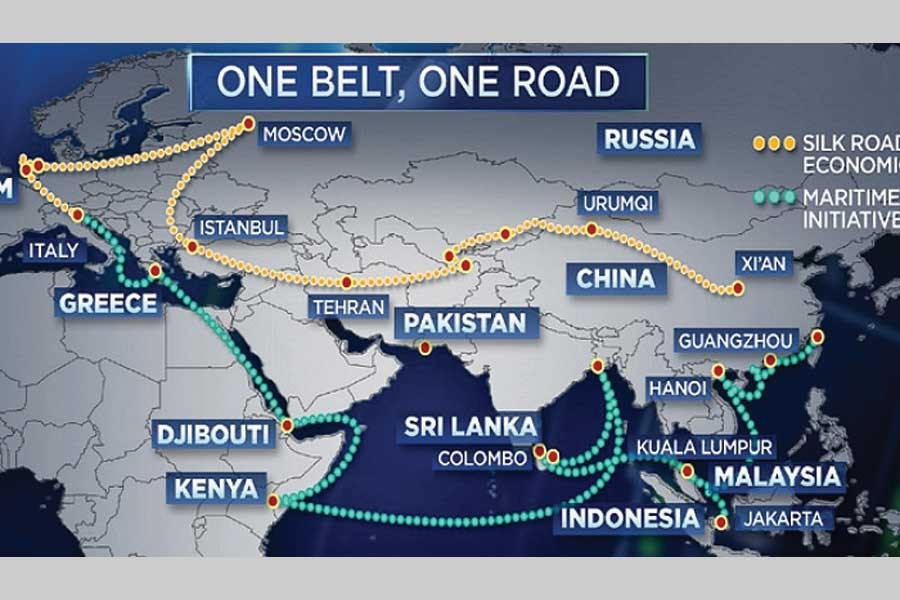
Shahiduzzaman Khan back from Beijing
Published :
Updated :

Flurries of recent activities surrounding the Belt and Road Initiative (BRI) in Beijing and elsewhere in China demonstrate that some positive changes in the economies and lifestyles in Asia and other parts of the region are in the offing.
In 2013, China's President Xi Jinping floated the concept of "Silk Road Economic Belt" during his visit to Central and South East Asia, which later on was called the Belt and Road Initiative. It was conceived to promote Chinese cooperation with Central Asia and South East Asia in the field of trade, connectivity, culture and exchange.
The BRI is aimed at providing other countries' access to China through railways and roads via seaports to speed up economic growth.
For Bangladesh, the initiative is likely to usher in a new era as the country will get needed funds to bankroll its mega infrastructure projects. Its affiliation with the BRI has already started bearing fruits as investment from China has accelerated.
In the past, China's involvement in Bangladesh was largely limited to EPC (engineering, procurement and construction) contractors and the country's investment was less than $1.0 billion in 2015. Recently the two countries signed an agreement on a 1,320-megawatt coal-fired power plant at Payra in Patuakhali involving $2.4 billion with both parties having equal shares.
A Chinese consortium, comprising the Shenzhen Stock Exchange and the Shanghai Stock Exchange, has bought 25 per cent stake of the Dhaka Stock Exchange, to become its strategic partner -- a move that has brought in roughly $125 million in investment.
Alipay, a concern of China's e-commerce and tech giant Alibaba Group, has bought 20 per cent stake in bKash, Bangladesh's largest mobile financial service provider, in an undisclosed amount of investment.
Bangladesh can seize the opportunity to take in external borrowing from China, given its low foreign debt-to-GDP (gross domestic product) ratio, which is now at 15 per cent. It can relieve the pressure by allowing liberalised foreign currency loans. Besides, it needs to develop the capital market, improve financial transparency further, raise the ease of doing business ranking and ramp up exports.
Even with the current growth rate, Bangladesh's economy would become a half-a-trillion dollar economy within the next five years. It is really the prime time for Bangladesh to rise up.
There is no denying that China is the most populated country in the world and most of the Asian countries, particularly the Southeast Asian economies, are dependent on China, as it is a key trading partner of these nations.
Since most of the Central Asian countries have small economies with lesser potential for investment, the overland transportation becomes expensive as compared to shipments by sea. China introduced a new idea of a maritime road which runs from the Chinese coast through Southeast Asia to the Indian Ocean and then to Europe.
The area covered by the BRI possesses 55 per cent of the world's gross national product (GNP), 70 per cent of the global population and 75 per cent of the known energy reserves. It has now become the main component of the regional economic strategy under the Chinese foreign policy.
Six economic corridors have been proposed under the BRI project by China. They include the Bangladesh-China-India-Myanmar Corridor. Some Asian countries including India and Japan are against the initiative and see it as a Chinese long-term Marshall Plan strategy to gain geopolitical dominance in Asia and the Asia Pacific region.
Analysts believe if the BRI is successfully implemented, it will give China more confidence in reshaping the world order. As a result, the balance of technology and growth will drift slowly and gradually towards Asia from Europe, says a study.
Asia is densely populated and home to more than 2.8 billion people with its land fertile for the IT and communication industry. It also has cheap labour and capital, rich in raw resources and has the tremendous absorbing capacity for new technologies and developments. All these factors will help improve the situation in favour of emerging Asian countries and will probably tip the regional balance in favour of Asia.
In the next two decades, the emerging Asian countries may stand out as the strongest opponents to the US supremacy in Asia and the Asia Pacific region. The impact of the BRI will help enhance the use of ICT in health, retail, security and business activities. It will also contribute to promotion of the digital culture, namely e-government, e-business, e-commerce, etc.
Over the past five years, China's trade with countries along the Belt and Road route exceeded USD 5.5 trillion. Chinese direct investment in the non-financial sectors of those countries reached USD 80 billion. China founded 82 overseas economic and trade cooperation zones in those countries, providing USD 8.9 billion worth of funds and thus creating 244,000 jobs.
Analysts say a mega project like the BRI will obviously face a lot of challenges and limitations in its implementation. There is, in fact, a need for efficient and effective management infrastructure to oversee and closely monitor its progress. The BRI is certainly a good initiative. It requires effective communication and strategic plans to be implemented successfully.
As Bangladesh is a key maritime nation in an important geo-strategic location along the BRI route, China wants it to play a major role in materialising the geo-economic and geo-connectivity vision.
szkhanfe@gmail.com


 For all latest news, follow The Financial Express Google News channel.
For all latest news, follow The Financial Express Google News channel.